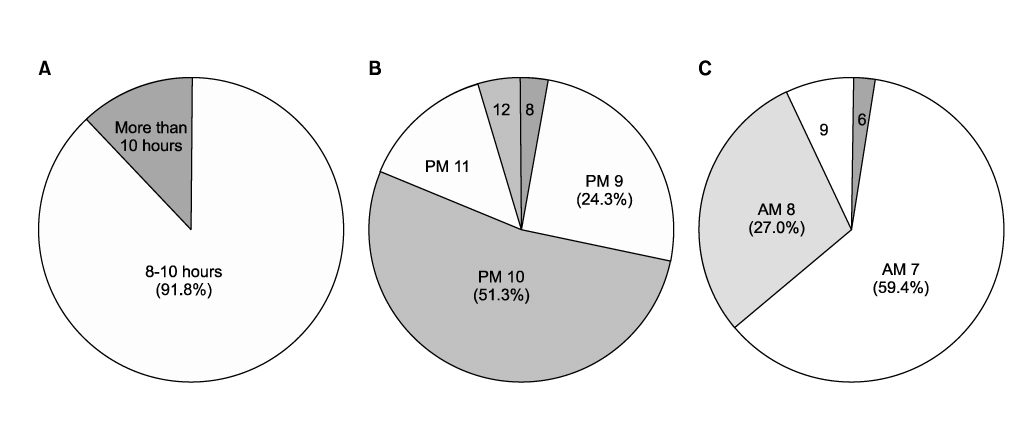Korean J Urol.
2008 Feb;49(2):168-173.
A Multicenter Prospective Study of the Effect of Imipramine and Desmopressin on Arousability in Children with Nocturnal Enuresis
- Affiliations
-
- 1Department of Urology, College of Medicine, Soonchunhyang University, Bucheon, Korea. urojun@schbc.ac.kr
- 2Department of Urology, Ilsan Hospital, Ilsan, Korea.
- 3Department of Pediatrics, Wonju College of Medicine, Yonsei University, Wonju, Korea.
- 4Department of Urology, Sungkyunkwan University School of Medicine, Seoul, Korea.
- 5Department of Pediatrics, College of Medicine, Yeungnam University, Daegu, Korea.
- 6Department of Urology, Pusan National University College of Medicine, Busan, Korea.
- 7Department of Pediatrics, Ewha Womans University College of Medicine, Korea.
- 8Department of Urology, College of Medicine, Inje University, Seoul, Korea.
Abstract
- PURPOSE
We performed a multicenter, prospective study to evaluate the efficacy of imipramine and desmopressin to improve arousability and prevent nocturnal enuresis(NE). MATERIALS AND METHODS: The total of 48 children with NE were given questionnaires that included a scoring system for the assessing arousal from sleep. They were assigned into two groups: group 1(imipramine 25 mg, 3 girls and 16 boys, mean age 7.9 years), group 2(desmopressin 0.2 mg, 9 girls and 9 boys, mean age 7.5 years). The assessment of arousability was repeated 2 weeks and 4 weeks after medication. Eleven children were excluded because of incomplete data. RESULTS: Mean wetting events in group 1 decreased from 8.8 to 5.1 times(2 weeks) and 3.0 times(4 weeks)(p=0.009) versus 10.2 to 5.5 times(2 weeks) and 6.4 times(4 weeks)(p=0.007) for group 2. The mean threshold of arousability in group 1 was 4.9(baseline), 4.4(2 weeks), and 3.7(4 weeks), and, for group 2, 5.1(baseline), 4.8(2 weeks), and 4.8(4 weeks). The two groups were not different(p=0.14, p=0.73). CONCLUSIONS: Imipramine and desmopressin, which are commonly used in treating NE in Korea, influenced wetting events but not arousability.
MeSH Terms
Figure
Reference
-
1. Neveus T. The role of sleep and arousal in nocturnal enuresis. Acta Paediatr. 2003. 92:1118–1123.2. Chandra M, Saharia R, Hill V, Shi Q. Prevalence of diurnal voiding symptoms and difficult arousal from sleep in children with nocturnal enuresis. J Urol. 2004. 172:311–316.3. Wolfish NM, Pivik RT, Busby KA. Elevated sleep arousal thresholds in enuretic boys: clinical implications. Acta Paediatr. 1997. 86:381–384.4. Wolfish NM. Sleep/arousal and enuresis subtypes. J Urol. 2001. 166:2444–2447.5. Kim L, Kim EJ. Textbook of neuropsychiatry. 2005. 2nd ed. Seoul: Jung-ang Publishing Inc;335–336.6. Sugaya K, Matsuyama K, Takakusaki K, Mori S. Electrical and chemical stimulations of the pontine micturition center. Neurosci Lett. 1987. 80:197–201.7. Bowden DM, German DC, Poynter WD. An autoradiographic, semistereotaxic mapping of major projections from locus coeruleus and adjacent nuclei in Macaca mulatta. Brain Res. 1978. 145:257–276.8. Biegon A, Rainbow TC. Localization and characterization of [3H]desmethylimipramine binding sites in rat brain by quantitative autoradiography. J Neurosci. 1983. 3:1069–1076.9. Yamadera H, Nakamura S, Suzuki H, Endo S. Effects of trazodone hydrochloride and imipramine on polysomnography in healthy subjects. Psychiatry Clin Neurosci. 1998. 52:439–443.10. Kawauchi A, Imada N, Tanaka Y, Yamao Y, Watanabe H. Effects of systematic treatment based on overnight simultaneous monitoring of electroencephalography and cystometry. Eur Urol. 1998. 33:Suppl 3. 58–61.11. Eggert P, Fritz A, Stecker B, Muller D. Desmopressin has an influence on the arousability of children with primary nocturnal enuresis. J Urol. 2004. 171:2586–2588.12. Born J, Kellner C, Uthgenannt D, Kern W, Fehm HL. Vasopressin regulates human sleep by reducing rapid-eye-movement sleep. Am J Physiol. 1992. 262:E295–E300.13. Moon SJ, Chung JY, Noh CH. The effect of imipramine and desmopressin on sleep arousal in nocturnal enuresis. Korean J Urol. 2004. 45:34–36.14. Kim WB, Kim KD. The epidemiology of childhood enuresis in Seoul and Kyunggi province. Korean J Urol. 1998. 39:1166–1170.15. Forsythe WI, Redmond A. Enuresis and spontaneous cure rate. Study of 1129 enuretis. Arch Dis Child. 1974. 49:259–263.16. Nappo S, Del Gado R, Chiozza ML, Biraghi M, Ferrara P, Caione P. Nocturnal enuresis in the adolescent: a neglected problem. BJU Int. 2002. 90:912–917.17. Norgaard JP, van Gool JD, Hjalmas K, Djurhuus JC, Hellstrom AL. Standardization and definitions in lower urinary tract dysfunction in children. International Children's Continence Society. Br J Urol. 1998. 81:Suppl 3. 1–16.18. Hjalmas K. Gearhart JP, Rink RC, Mouriquand PD, editors. Nocturnal enuresis. Pediatric urology. 2001. 1th ed. Philadelphia: Saunders;497.19. Christmanson L, Lisper H. Parent behaviors related to bed wetting and toilet-training as etiological factors in primary enuresis. Scand J Behav Ther. 1982. 11:29–37.20. Butler RJ, Golding J, Heron J. ALSPAC Study Team. Nocturnal enuresis: a survey of parental coping strategies at 7 1/2 years. Child Care Health Dev. 2005. 31:659–667.
- Full Text Links
- Actions
-
Cited
- CITED
-
- Close
- Share
- Similar articles
-
- The Effectiveness of Imipramine and Desmopressin in the Treatment of Enuresis
- The Effect of Imipramine and Desmopressin on Sleep Arousal in Nocturnal Enuresis
- Pharmacological therapy of nocturnal enuresis
- The Efficacy of Intranasal Desmopressin in the Treatment of Nocturnal Enuresis
- The Effect of Imipramine and Desmopressin for the Treatment of Enuresis in Attention Deficit Hyperactivity Disorder Children


